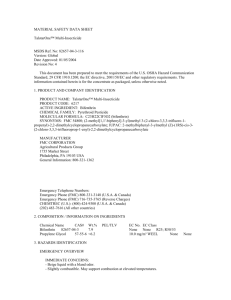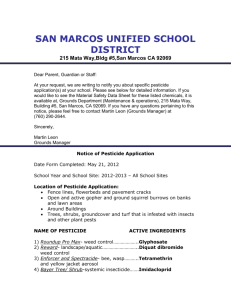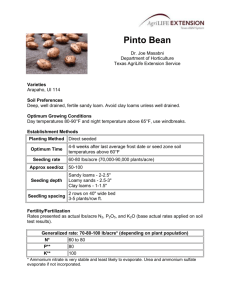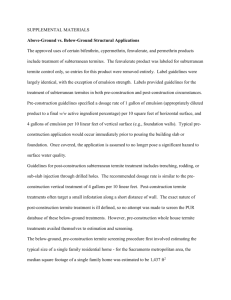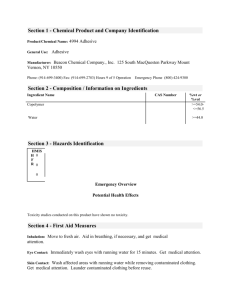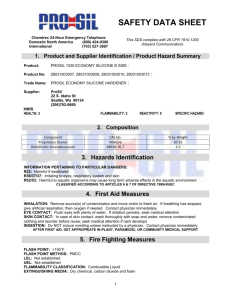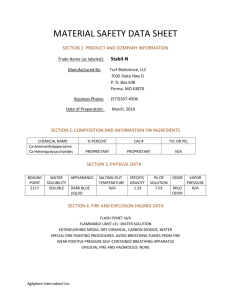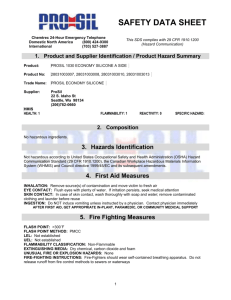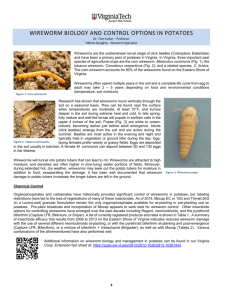section 11 - toxicological information
advertisement
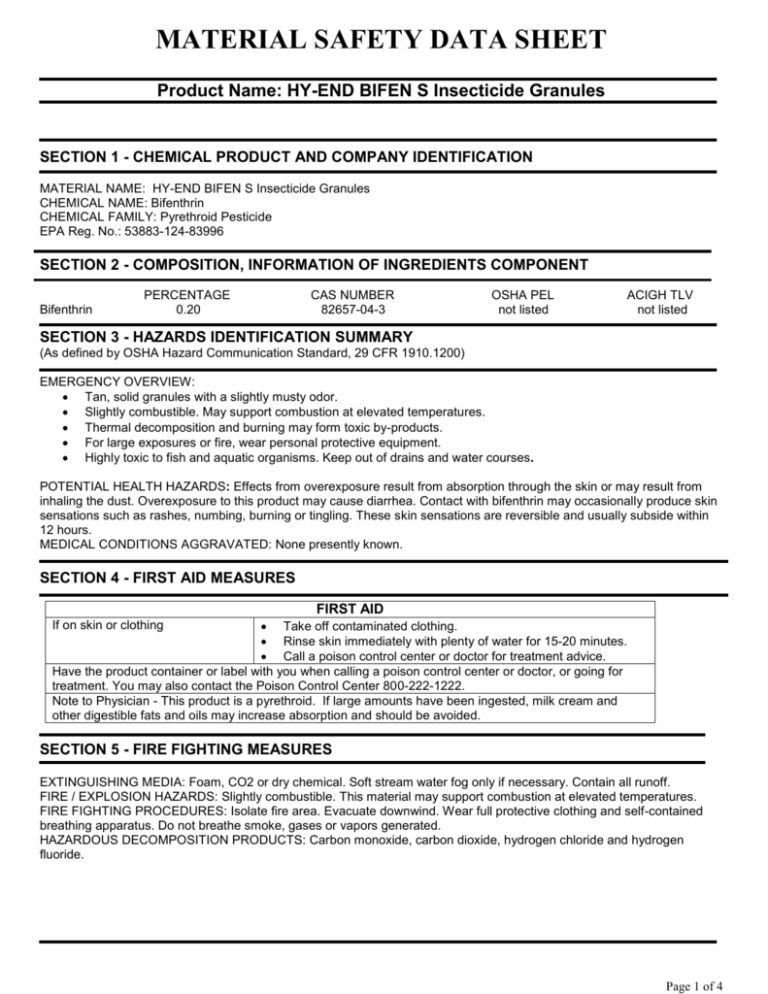
MATERIAL SAFETY DATA SHEET Product Name: HY-END BIFEN S Insecticide Granules SECTION 1 - CHEMICAL PRODUCT AND COMPANY IDENTIFICATION MATERIAL NAME: HY-END BIFEN S Insecticide Granules CHEMICAL NAME: Bifenthrin CHEMICAL FAMILY: Pyrethroid Pesticide EPA Reg. No.: 53883-124-83996 SECTION 2 - COMPOSITION, INFORMATION OF INGREDIENTS COMPONENT Bifenthrin PERCENTAGE 0.20 CAS NUMBER 82657-04-3 OSHA PEL not listed ACIGH TLV not listed SECTION 3 - HAZARDS IDENTIFICATION SUMMARY (As defined by OSHA Hazard Communication Standard, 29 CFR 1910.1200) EMERGENCY OVERVIEW: Tan, solid granules with a slightly musty odor. Slightly combustible. May support combustion at elevated temperatures. Thermal decomposition and burning may form toxic by-products. For large exposures or fire, wear personal protective equipment. Highly toxic to fish and aquatic organisms. Keep out of drains and water courses. POTENTIAL HEALTH HAZARDS: Effects from overexposure result from absorption through the skin or may result from inhaling the dust. Overexposure to this product may cause diarrhea. Contact with bifenthrin may occasionally produce skin sensations such as rashes, numbing, burning or tingling. These skin sensations are reversible and usually subside within 12 hours. MEDICAL CONDITIONS AGGRAVATED: None presently known. SECTION 4 - FIRST AID MEASURES FIRST AID Take off contaminated clothing. Rinse skin immediately with plenty of water for 15-20 minutes. Call a poison control center or doctor for treatment advice. Have the product container or label with you when calling a poison control center or doctor, or going for treatment. You may also contact the Poison Control Center 800-222-1222. Note to Physician - This product is a pyrethroid. If large amounts have been ingested, milk cream and other digestible fats and oils may increase absorption and should be avoided. If on skin or clothing SECTION 5 - FIRE FIGHTING MEASURES EXTINGUISHING MEDIA: Foam, CO2 or dry chemical. Soft stream water fog only if necessary. Contain all runoff. FIRE / EXPLOSION HAZARDS: Slightly combustible. This material may support combustion at elevated temperatures. FIRE FIGHTING PROCEDURES: Isolate fire area. Evacuate downwind. Wear full protective clothing and self-contained breathing apparatus. Do not breathe smoke, gases or vapors generated. HAZARDOUS DECOMPOSITION PRODUCTS: Carbon monoxide, carbon dioxide, hydrogen chloride and hydrogen fluoride. Page 1 of 4 SECTION 6 - ACCIDENTAL RELEASE MEASURES RELEASE NOTES: Isolate and post spill area. Wear protective clothing and personal protective equipment as prescribed in Section 8, "Exposure Controls/Personal Protection". Keep unprotected persons and animals out of the area. Keep material out of lakes, streams, ponds and sewer drains. Large spills should be covered to prevent dispersal. For dry material, use a wet sweeping compound or water to prevent the formation of dust. If water is used, prevent runoff or dispersion of excess liquid by diking and absorbing with a non-combustible absorbent such as clay, sand or soil. Vacuum, shovel or pump all waste material, including absorbent, into a drum and label contents for disposal. To clean and neutralize spill area, tools and equipment, wash with a suitable solution of caustic or soda ash, and an appropriate alcohol (i.e., methanol, ethanol or isopropanol). Follow this by washing with a strong soap and water solution. Absorb, as above, any excess liquid and add to the drums of waste already collected. Repeat if necessary. Dispose of drummed waste according to the method outlined in Section 13, "Disposal Considerations". SECTION 7 – HANDLING AND STORAGE KEEP OUT OF REACH OF CHILDREN PROHIBITIONS Do not contaminate water, food, or feed by storage or disposal. PESTICIDE STORAGE Keep out of reach of children and animals. Store in original containers only. Store in a cool, dry place and avoid excess heat. Carefully open containers. After partial use close tightly. In case of spill, avoid contact, isolate area and keep out animals and unprotected persons. Confine spills. To confine spill: Cover to prevent dispersal. Place damaged package in a holding container. Identify contents. PESTICIDE DISPOSAL Wastes resulting from the use of this product may be disposed of on site or at an approved waste disposal facility. CONTAINER DISPOSAL Paper and plastic bags: Completely empty bag into application equipment. Then dispose of empty bag in a sanitary landfill or by incineration, or, if allowed by state and local authorities, by burning. If burned, stay out of smoke. SECTION 8 - EXPOSURE CONTROLS, PERSONAL PROTECTION ENGINEERING CONTROLS: Use local exhaust at all process locations where vapor or mist may be emitted. Ventilate all transport vehicles prior to unloading. PERSONAL PROTECTIVE EQUIPMENT: EYES AND FACE: For dust exposure, wear chemical protective goggles or a face shield. RESPIRATORY: For splash, mist or spray exposure wear, as a minimum, a properly fitted half-face or full-face airpurifying respirator which is approved for pesticides (U.S. NIOSH/MSHA, EU CEN or comparable certification organization). Respirator use and selection must be based on airborne concentrations. PROTECTIVE CLOTHING: Depending upon concentrations encountered, wear coveralls or long-sleeved uniform and head covering. For larger exposures as in the case of spills, wear full body cover barrier suit, such as a PVC suit. Leather items - such as shoes, belts and watchbands - that become contaminated should be removed and destroyed. Launder all work clothing before reuse (separately from household laundry). WORK HYGIENIC PRACTICES: Clean water should be available for washing in case of eye or skin contamination. Wash skin prior to eating, drinking or using tobacco. Shower at the end of the workday. GLOVES: Wear chemical protective gloves made of materials such as rubber, neoprene, or PVC. Thoroughly wash the outside of gloves with soap and water prior to removal. Inspect regularly for leaks. SECTION 9 - PHYSICAL AND CHEMICAL PROPERTIES ODOR: Slightly musty APPEARANCE: Tan solid granule DENSITY: 1.39 g/mL (85 - 89 lb/cu ft.) MOLECULAR WEIGHT: 422.88 (bifenthrin) SECTION 10 - STABILITY AND REACTIVITY CHEMICAL STABILITY: Stable. CONDITIONS TO AVOID: High temperatures and fire. HAZARDOUS POLYMERIZATION: Product will not undergo polymerization. Page 2 of 4 SECTION 11 - TOXICOLOGICAL INFORMATION ACUTE TOXICITY: DERMAL LD50: >2000 mg/kg (rabbit) ORAL LD50: >5000 mg/kg (rat) ACUTE EFFECTS FROM OVEREXPOSURE: This product has low oral and dermal toxicity. It is non-irritating to the eyes and skin. Excessive exposure to dust may irritate the respiratory system, skin and eyes. This product caused diarrhea in laboratory animals. Bifenthrin does not cause acute delayed neurotoxicity. Experience to date indicates that contact with bifenthrin may occasionally produce skin sensations such as rashes, numbing, burning or tingling. These sensations are reversible and usually subside within 12 hours. CHRONIC EFFECTS FROM OVEREXPOSURE: No data available for the formulation. In studies with laboratory animals, bifenthrin did not cause reproductive toxicity or teratogenicity. Tremors were associated with repeated exposure of laboratory animals to bifenthrin. In lifetime feeding studies conducted with rodents, a slight increase in the incidence of urinary bladder tumors at the highest dose in male mice was considered to be an equivocal response, not evidence of a clear compound-related effect. The overall absence of genotoxicity has been demonstrated in mutagenicity tests with bifenthrin. CARCINOGENICITY: IARC: Not listed NTP: Not listed OSHA: Not listed OTHER: Not Listed (ACGIH). SECTION 12 - ECOLOGICAL INFORMATION Unless otherwise indicated, the data presented below are for the active ingredient. ENVIRONMENTAL DATA: In soil, bifenthrin is stable over a wide pH range and degrades at a slow rate which is governed by soil characteristics. Bifenthrin will also persist in aquatic sediments. Bifenthrin has a high Log Pow (>6.0), a high affinity for organic matter, and is not mobile in soil. Therefore, there is little potential for movement into ground water. There is the potential for bifenthrin to bioconcentrate (BCF = 11, 750). ECOTOXICOLOGICAL INFORMATION: Bifenthrin is highly toxic to fish and aquatic arthropods and LC50 values range from 0.0038 to 17.8 µg/L. In general, the aquatic arthropods are the most sensitive species. Care should be taken to avoid contamination of the aquatic environment. Bifenthrin had no effect on mollusks at its limit of water solubility. Bifenthrin is only slightly toxic to both waterfowl and upland game birds (LD50 values range from 1,800 mg/kg to >2,150 mg/kg). SECTION 13 – DISPOSAL CONSIDERATIONS WASTE: Dispose of in accordance with applicable Federal, state and local laws and regulations. CONTAINER: Completely empty bag into application equipment. Do not reuse container. Dispose of empty bag in a sanitary landfill or by incineration, or, if allowed by State and local authorities, by burning. If burned, stay out of smoke. SECTION 14 – TRANSPORT INFORMATION DOT SHIPPING DESCRIPTION: Insecticides, NOI, other than Poison. NMFC Item 102120. DOT HAZARD CLASS: not regulated UN NUMBER: N/A DOT PACKING GROUP: N/A DOT PRIMARY/SUBSIDIARY LABEL: N/A DOT PRIMARY/SUBSIDIARY PLACARD: N/A DOT EMERGENCY RESPONSE GUIDE #: N/A REPORTABLE QUANTITY (RQ): None MARINE POLLUTANT #1: bifenthrin (Severe Marine Pollutant - see 'Other Shipping Information' below) OTHER SHIPPING INFORMATION: Bifenthrin is a severe marine pollutant, but is not regulated in concentrations less than 1%. This material is not regulated for transport via any mode. Page 3 of 4 SECTION 15 - REGULATORY INFORMATION SARA TITLE III (SUPERFUND AMENDMENTS AND REAUTHORIZATION ACT) SECTION 302 EXTREMELY HAZARDOUS SUBSTANCES (40 CFR 355): Not listed SECTION 311 HAZARD CATEGORIES (40 CFR 370): Immediate, Delayed SECTION 312 THRESHOLD PLANNING QUANTITY (40 CFR 370): The threshold planning quantity (TPQ) for this product, if treated as a mixture, is 10,000 lbs. This product contains the following ingredients with a TPQ of less than 10,000 lbs.: None SECTION 313 REPORTABLE INGREDIENTS (40 CFR 372): There are no ingredients in this product which are subject to Section 313 reporting requirements. FIFRA: All pesticides are governed under the Federal Insecticide, Fungicide, and Rodenticide Act. The regulatory information presented below is pertinent only when this product is handled outside of the normal use and application as a pesticide. OSHA HAZARD COMMUNICATION STANDARD STATUS: Regulated CERCLA REPORTABLE QUANTITY: N/A CALIFORNIA PROP 65 STATUS: Not listed The information herein is given in good faith, but no warranty, expressed or implied, is made. NaturChem Inc 270 Bruner Road Lexington, SC 29072 EMERGENCY TELEPHONE NUMBERS: (800) 424-9300 (CHEMTREC, transportation and spills) (800) 222-1222 (Poison Control Center, human health) Date: 08/23/2010 Page 4 of 4
